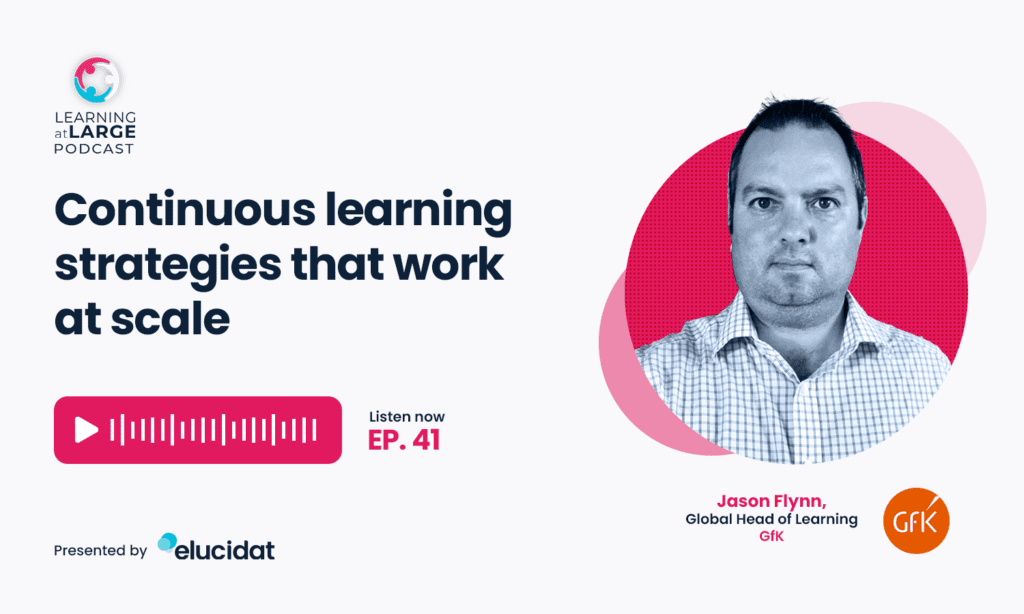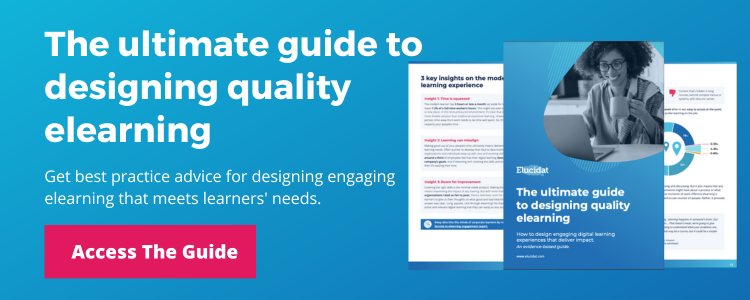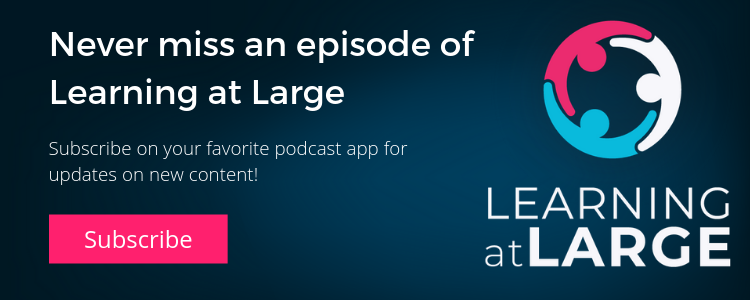Continuous Learning Strategies At Scale: Jason Flynn
The skills and knowledge businesses need to succeed are constantly evolving. If you’re going to keep up, learning and development needs to be an ongoing process. But what does this involve? Hear how Jason Flynn, Global Head of Learning at GfK, has developed continuous learning strategies that work at scale. Explore how building flexible learning habits enables employees and organizations to grow. Find out why user feedback is essential to the success of continuous learning.

Top tips for embracing continuous learning at scale
Don’t have time to listen now? Here are some top tips from Jason:
- Build habits, not just courses: Help your people recognize that learning isn’t a one-off activity. Make continuous learning part of your culture.
- Embrace flexible learning strategies: Provide flexibility with a range of learning opportunities. Empower people to own their career development and do it their way.
- Open up learning to everyone: Get everyone engaged in learning with open learning sessions. Make all your learning resources accessible to every employee.
- Create a two-way dialogue: Use feedback to understand the success of your continuous learning culture. Feed what you’ve learnt into developing new learning opportunities.
1. Build habits, not just courses
Whatever industry you work in, you’ll have noticed the accelerated pace of change in recent years. Whether you’re responding to the great resignation or advances in technology, your organization needs an evolving skill set to stay relevant in the short and long term.
For Jason, it’s not just about deploying the right tools and techniques. If your people are going to develop the skills required for success, they need the right attitudes and behaviors. This starts with recognizing that learning isn’t finite. It’s an ongoing process. L&D is only effective if it’s integrated in to the flow of work and becomes a daily habit.
“Continuous learning isn’t about spending half day in a class. It’s about finding five minutes to dip into some microlearning or to start a series of courses, or watch a YouTube video, or even read an article, or whatever it is. Learning doesn’t stop with what we offer on the platform. We need to make people aware that there’s lots of other opportunities out there for them…We’re not asking for a massive commitment, but to do things as a habit regularly.”
2. Embrace flexible learning strategies
Building a continuous learning culture is an ongoing journey for most organizations. To stay on track, you need to get people’s attention and keep them learning.
With learning environments transformed by the pandemic, Jason and his team were looking for new ways to keep their global employees engaged.
After exploring a variety of ideas, they started to run monthly Learning Live sessions. Open to all employees, the sessions see external thought leaders discuss topics that are universally relevant. They’ve not only been getting great feedback, but have seen an upsurge in employees wanting to explore further.
“That’s something that I’m really passionate about throughout the whole of our learning offering. Within our elearning platform, for example, I don’t close anything off. I don’t want leadership training just to be there for leaders. I want people that aspire to be leaders to be following the training. I don’t want anything closed. And I think that really helps with the overall end game of continuous learning.”
3. Open up learning to everyone
People will only develop continuous learning habits if they can learn in the ways that are right for them. From mobile learning on-the-go to the latest discussions on social media, provide flexibility with a wide range of learning opportunities. Embracing flexible learning strategies empowers people to own their career development.
Jason has seen this first hand. In 2019, he was ready to kick off classroom training for GfK’s global commercial team. When the pandemic hit, they had to pivot to a flexible blended learning approach. The two-day workshop became a 16-week program of learning, including a mix of elearning and live online coaching. The learners continued their learning journey with online resources and ongoing updates. And the result was a learning experience with impact.
“People thought it was great because they had time to reflect on their learning and come back, give some feedback, get some coaching – all of those things that we couldn’t really do previously in a couple of days in a classroom…But it didn’t end there. Too often in the past, we’ve created learning programs, and that’s the endpoint. But learning shouldn’t end. So around it, we built lots of different things to support people who are going through that training…and make sure the training was embedded.”
4. Creating a two-way dialogue
Everything L&D does should work to create a culture of continuous learning. So how do you know you’re heading in the right direction?
There are plenty of digital learning data points that can measure engagement. But, for Jason, it’s learner feedback that really shows that your people are embracing continuous learning. And this anecdotal feedback isn’t just a key measure. It essential to setting the direction for where L&D goes next.
“There are statistical measures for engagement with the training that we’re offering… But to understand the impact of continual learning it’s the anecdotal stuff. It’s the people coming up to me and asking for more learning opportunities. And I think that’s great because I want to get that two-way dialogue going. It’s not just about what the company is pushing. It’s about me taking on board what I see and hear in the organization and trying to provide something before people realize it’s needed.”
A quick recap
The skills needed for businesses to succeed are always evolving. If you’re going to keep up, employees learning and developing needs to be a constant process. Jason has four strategies to foster a culture of continuous learning.
- Build lifelong learning habits, rather than just elearning courses.
- Offer freedom and flexibility to empower people to own their personal development.
- Keep learning open and accessible to everyone.
- Create a two-way dialogue with your learners to measure your success and continually improve.
Want to find out more? Check out the full podcast.
About Jason
With over 20 years’ experience in L&D, Jason has taken on a variety of roles at GfK. As Global Head of Learning, he’s responsible for learning initiatives that drive and support GfK’s transformation.
You can find out more and get connected with Jason on LinkedIn.
On Jason’s listening and reading list
Explore the books that are influencing Jason’s approach to compliance training.
This book explores how fears provoke people to unknowingly sabotage their ability to build trust and loyalty. It helped Jason embrace his vulnerability when working with senior people and Subject Matter Experts (SMEs).
Black Box Thinking: The Surprising Truth About Success, Matthew Syed
Great performers and teams are driven by a curiosity for marginal gains. Jason sees this as really important for L&D, where even a small change can make a big difference to learners.
Looking for more reading tips? Check out our book blog.
Join the conversation!
We’d love to hear your thoughts on our podcast, so feel free to get in touch with our podcast host, at kirstie.greany@elucidat.com. As always, don’t forget to subscribe to Learning at Large in your favorite podcast app and leave us a 5-star rating if you enjoyed it. Thank you for joining us, and see you next time.

